Investigators working on the Columbia accident said this week that the launch photos from a key camera were too blurry to provide useful images. Sharper images of foam falling from the external tank and crashing into the wing might have given NASA more reason to take the situation seriously. The investigators recommended that NASA upgrade its camera systems for future launches, and consider additional views from airplanes and ships.
Two Telescopes Act as One
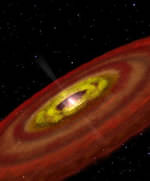
Image credit: NASA
Astronomers have directly observed a hot disc of dust and gas surrounding a protostar using the twin W.M. Keck telescopes in Hawaii. This is the first published science observation using a technology called interferometry, which combines the light from several telescopes to act as a larger observatory – the twin 10-metre Keck telescopes act as a virtual 85 metre telescope. The observation was of DG Tau, a T-Tauri object which is so young its centre star hasn’t begun burning hydrogen; it’s surrounded by a disc of dust and gas that could form planets.
Astronomers have observed a young star ringed by a swirling disc that may spin off planets, marking the first published science observation using two linked 10-meter (33- foot) telescopes in Hawaii.
The linked telescopes at the W.M. Keck Observatory on Mauna Kea, known as the Keck Interferometer, comprise the world’s largest optical telescope system. The observation was made of DG Tau, a young star that has not yet begun to burn hydrogen in its core. Such stars are called T-Tauri objects. Observations of DG Tau were made on October 23, 2002, and February 13, 2003, and the findings will appear in an upcoming issue of the Astrophysical Journal Letters.
“We’re trying to measure the size of the hot material in the dust disc around DG Tau, where planets may form,” said Dr. Rachel Akeson, leader of the study team and an astronomer at the Michelson Science Center at the California Institute of Technology in Pasadena. “Studies like this teach us more about how stars form, either alone or in pairs, and how planets eventually form in discs around stars.”
The Keck Interferometer observations revealed a gap of 18 million miles between DG Tau and its orbiting dust disc. Akeson notes that of the extra-solar planets – planets orbiting other stars – discovered so far, roughly one in four lies within 10 million miles of the parent star. Since planets are believed to form within a dust disc, either DG Tau’s disc has a larger-than-usual gap, or the close-in planets form farther from the star and migrate inward.
Since 1995, astronomers have detected more than 100 extra- solar planets, many considered too large and close to their hot, parent stars to sustain life. By measuring the amount of dust around other stars, where planets may form, the Keck Interferometer will pave the way for NASA’s Terrestrial Planet Finder mission. Terrestrial Planet Finder will look for smaller, Earth-like planets that may harbor life. The Keck Interferometer and Terrestrial Planet Finder are part of NASA’s Origins Program, which seeks to answer the questions: Where did we come from? Are we alone?
“T-Tauri objects had been observed with other instruments, but only the brightest ones were detectable until now,” Akeson said. “With the larger telescopes and greater sensitivity of the Keck Interferometer, we can look at fainter T-Tauri objects, like this one.”
The Keck Interferometer gathers light waves with two telescopes and then combines the waves so they interact, or “interfere” with each other. It’s like throwing a rock into a lake and watching the ripples, or waves, and then throwing in a second rock. The second set of waves either bumps against the first set and changes its pattern, or both sets join together to form larger, more powerful waves. With interferometry, the idea is to combine light waves from multiple telescopes to simulate a much larger, more powerful telescope.
In its ability to resolve fine details, the Keck Interferometer is equivalent to an 85-meter (279-foot) telescope. “The system transports the light gathered by the two telescopes to an optical laboratory located in the central building,” said Dr. Mark Colavita of NASA’s Jet Propulsion Laboratory (JPL), Pasadena, interferometer system architect and lead author of the paper. “In the lab, a beam combiner and infrared camera combine and process the collected light to make the science measurement.”
To make these measurements, the interferometer’s optical system adjusts the light paths to a fraction of a wavelength of light, and adaptive optics on the telescopes remove the distortion caused by Earth’s atmosphere.
“This research represents the first scientific application of an interferometer with telescopes that use adaptive optics,” said Dr. Peter Wizinowich, interferometer team lead for the W.M. Keck Observatory and co-author of the paper.
The development of the Keck Interferometer is managed by JPL for NASA’s Office of Space Science, Washington. JPL is a division of the California Institute of Technology in Pasadena. The W.M. Keck Observatory is funded by Caltech, the University of California and NASA, and is managed by the California Association for Research in Astronomy, Kamuela, Hawaii.
Original Source: NASA News Release
Astronomers Find Seven New Planets
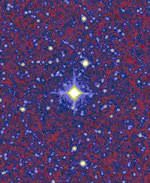
Image credit: NASA
A team of European astronomers announced this week that they have discovered seven new planets, bringing the total of extrasolar planets discovered to 115. Six of the planets circle stars that weren’t previously known to contain planets. All are gas giants, ranging in size from slightly smaller than Jupiter up to eight times the mass of Jupiter. They were detected using the radial velocity method, where astronomers watch for back and forth movement of a star caused by interaction with its planet. There are currently 30 teams searching for planets around other stars.
European astronomers this week announced the discovery of seven new planets orbiting other stars, bringing to 115 the total number of known extrasolar planets. Six of the new planets circle stars not previously known to harbor planets, while the seventh orbits a star where another planet had been detected earlier.
All of the new planets are gas giants, ranging in size from slightly smaller than Jupiter to nearly eight-times the mass of Jupiter. They were detected using the radial velocity method, which infers the presence of an unseen companion because of the back-and-forth movement it induces in the host star. This movement is detectable as a periodic red shift and blue shift in the star’s spectral lines. (For more about this method, see the article Finding Planets.)
A team led by Michel Mayor, as part of the ongoing Geneva Extrasolar Planet Search program, was responsible for six of the new discoveries: HD 65216, HD111232, HD142415, HD216770, HD10647 and HD 169830. In 1995, Mayor was co-discoverer, along with Didier Queloz, of 51 Pegasi, the first known planet around another star.
Additionally, Japanese astronomers last week announced the discovery of a new planet around a giant star (also using radial velocity). This new planet, HD 104985 b, is more than six time the mass of Jupiter. It was the first to be discovered by a Japanese planet-search team, according the Extrasolar Planets Encyclopedia.
There are currently more than 30 planet-search programs under way worldwide using ground-based telescopes. While none of the planets detected thus far is believed to have the potential to support life, NASA is developing a suite of space-based missions that will be capable of detecting for smaller, habitable planets within the next decade. See the links at left under “Missions” for information on NASA’s planet-finding missions, which include the Space Interferometery Mission, Kepler and Terrestrial Planet Finder.
Original Source: NASA News Release
Eurockot Launches Nine Satellites
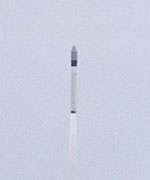
Image credit: Eurockot
A Russian Rockot booster successfully launched nine microsatellites into different orbits on Monday. The Rockot, a converted RS-18 intercontinental ballistic missile, lifted off from the Plesetsk cosmodrome in Northern Russia and reached orbit 10 minutes later. The largest satellite on board the booster was a mockup of the Monitor E, a Russian remote sensing satellite. It also carried the 60 kg Canadian-built MOST space observatory, designed to measure minute fluctuations in the brightness of stars, as well as microsatellites built at various universities around the world.
Eurockot Launch Services GmbH successfully launched the Multiple Orbit Mission into different orbits today at 14:15 GMT using the ROCKOT launch system from Plesetsk Cosmodrome in Northern Russia. The multiple payload consisted of 8 micro- and nano-satellites for scientific purposes as well as a satellite simulator. This launch is Eurockot`s first sun-synchronous mission.
The ROCKOT launch vehicle successfully deployed the Czech republic`s MIMOSA spacecraft into an elliptical orbit of 820 x 320 km and the Canadian Space Agency`s MOST spacecraft, together with a host of nano-satellites, including the Japanese Cubesat and CUTE-1, the Canadian Can X-1, the Danish AAU Cubesat and DTUsat, the US Quakesat, into a sun-synchronous orbit of 820 km. Next to demonstrating the multiple orbit deployment capability of its Breeze upper stage, this launch was also Eurockot`s first sun-synchronous mission. The ninth payload of this mission, a mass frequency simulator of the Russian MONITOR satellite, intentionally remained on Breeze and will burn up during deorbiting.
Like most of its co-passengers, MIMOSA will perform a scientific mission. The Czech Astronomical Institute will use it to measure the density of the earth’s upper atmosphere. MOST will carry Canada`s first space telescope and will probe the age of planets and stars for the Canadian Space Agency. The Japan spacecraft Cubesat Xl and CUTE-1 are educational nano-satellites of the University of Tokyo and the Tokyo Institute of Technology.
The main purposes of CanX-1, AAU Cubesat and DTUsat is star-imaging. They will be operated for the University of Toronto, Aalborg University and the Danish Technical University respectively. Quake-sat`s mission will be the detection of earthquakes for the Quake-Finder Institute.
With the Mutiple Orbit Mission (MOM), Eurockot demonstrated the unique capability of its Breeze upper stage: multiple reignitions allow it to be precisely positioned into different orbits and release several spacecraft successively.
Eurockot`s next launch will be performed in October 2003 for the Japanese Institute for Unmanned Space Experiment Free Flyer (USEF) by deploying its SERVIS-1 spacecraft into a sun-synchronous orbit of 1000 km altitude. Eurockot Launch Services GmbH is the joint venture of EADS SPACE Transportation (51%) and Khrunichev Space Centre (49%) and performs launch services for operators of Low Earth Orbit (LEO) satellites using the flight-proven Rockot launch vehicle. Future launches in 2004 comprise ESA`s CRYOSAT and the Korea Aerospace Research Institute`s KOMPSAT-2 missions.
Original Source: Eurocket News Release
Gemini Pictures Rival Hubble
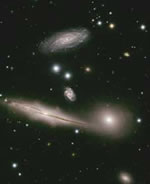
Image credit: Gemini
Thanks to its adaptive optics system and new imaging spectrograph, the Gemini observatory in Chile is producing images that rival those taken by the Hubble Space Telescope. One image of the Hickson Compact Group 87 (HGC87), a group of galaxies located 400 million light years away in the constellation of Capricornus, looks identical to that taken by Hubble. The seven-metre Gemini South is still being tested, but it’s expected to begin scientific operations in August, 2003.
Gemini Observatory’s new imaging spectrograph, without the help of adaptive optics, recently captured images that are among the sharpest ever obtained of astronomical objects from the ground.
Among the images and spectra acquired during recent commissioning of the Gemini Multi-Object Spectrograph (GMOS) on the 8-meter Gemini South Telescope, one image is particularly compelling. This Gemini image reveals remarkable details, previously only seen from space, of the Hickson Compact Group 87 (HCG87). HCG87 is a diverse group of galaxies located about 400 million light years away in the direction of the constellation Capricornus. A striking comparison with the Hubble Space Telescope Heritage image of this object, including resolution data, can be viewed at http://www.gemini.edu/media/images_2003-3.html.
“Historically, the main advantage of large ground-based telescopes, like Gemini, is their ability to collect significantly more light for spectroscopy than is possible with a telescope in space,” said Phil Puxley, Associate Director of the Gemini South Telescope. He explains, “The Hubble Space Telescope is able to do things that are impossible from the ground. However, ground-based telescopes like Gemini, when conditions are right, approach the quality of optical images now only possible from space. One key area – spectroscopy of faint objects, which requires large apertures and fine image quality – is where large telescopes like Gemini provide a powerful, complementary capability to space-based telescopes.”
GMOS-South is currently undergoing commissioning on the 8-meter Gemini South Telescope at Cerro Pach?n, Chile. “GMOS-South worked right out of the box, or rather, right out of the 24 crates that brought the 2-ton instrument to Chile from Canada and the UK – just like its northern counterpart did when it arrived on Hawaii’s Mauna Kea,” says Dr. Bryan Miller, head of the commissioning team. “The GMOS program demonstrates the advantage of building two nearly identical instruments. Experience and software from GMOS-North have helped us commission this instrument more rapidly and smoothly than we could have done otherwise,” explains Dr. Miller. He adds, “Although the images from GMOS-South are spectacular, the instrument is primarily a spectrograph and that is where its capabilities are most significant for scientists.” GMOS-South is expected to begin taking science data in August 2003.
As a multi-object spectrograph, GMOS is capable of obtaining hundreds of spectra in one “snapshot.” The ability to deliver high-resolution images is a secondary function. “It used to take an entire night to obtain one spectrum,” explains Dr. Inger J?rgensen, who led the commissioning of the first GMOS instrument on the Frederick C. Gillett Gemini Telescope (Gemini North) over a year ago. “With GMOS, we can collect 50-100 spectra simultaneously. Combined with Gemini’s 8-meter mirror, we are now able to efficiently study galaxies and galaxy clusters at vast distances – distances so large that the light has traveled for half the age of the Universe or more before reaching Earth. This capability presents unprecedented possibilities for investigating how galaxies formed and evolved in the early Universe.”
GMOS achieves this remarkable sensitivity partly because of its technologically advanced detector, which consists of over 28 million pixels, and partly because of multiple innovative features of the Gemini dome and telescope that reduce local atmospheric distortions around the telescope. “When we designed Gemini, we paid careful attention to controlling heat sources and providing excellent ventilation,” said Larry Stepp, former Gemini Optics Manager. Stepp elaborates, “For example, we constructed 3-story-high vents on the sides of the Gemini enclosures. It is great to see this image that provides such a dramatic validation of our approach.”
“The twin Gemini Telescopes offer a unique advantage,” explains Director of the Gemini Observatory Dr. Matt Mountain. “Now that both telescopes are equipped with nearly identical GMOS instruments, we have created an unprecedented uniform platform to coherently study and take deep spectra of any object in the northern or southern sky at optical wavelengths.”
Upgrades to GMOS-South that will increase its variety of capabilities are planned even as the instrument is undergoing commissioning. An Integral Field Unit (IFU) on GMOS-South is anticipated to begin commissioning in early 2004. Jeremy Allington-Smith, leader of the IFU team at the University of Durham said, “GMOS-South will soon be fitted with an integral field unit like its sister on Gemini North. Made by the University of Durham, it uses more than a thousand optical fibers, tipped at each end with microscopic lenses, to dissect the object under study. This gives GMOS a 3-D view of the target, in which each pixel in the image is replaced by a spectrum. This innovation allows GMOS to make detailed maps of, for example, the motion of stars and gas in galaxies.”
GMOS was built as a joint partnership between Gemini, Canada and the UK. Separately, the U.S. National Optical Astronomy Observatory provided the highly capable detector subsystem and related software (http://www.noao.edu/usgp). It is anticipated that GMOS-South will be available for full scientific operations in August 2003 when astronomers from the seven-country Gemini partnership will begin using the instrument for a wide variety of scientific studies.
The Gemini Observatory is an international collaboration that has built two identical 8-meter telescopes. The Frederick C. Gillett Gemini Telescope is located at Mauna Kea, Hawai`i (Gemini North) and the other telescope at Cerro Pach?n in central Chile (Gemini South), and hence provide full coverage of both hemispheres of the sky. Both telescopes incorporate new technologies that allow large, relatively thin mirrors under active control to collect and focus both optical and infrared radiation from space.
The Gemini Observatory provides the astronomical communities in each partner country with state-of-the-art astronomical facilities that allocate observing time in proportion to each country’s contribution. In addition to financial support, each country also contributes significant scientific and technical resources. The national research agencies that form the Gemini partnership include: the US National Science Foundation (NSF), the UK Particle Physics and Astronomy Research Council (PPARC), the Canadian National Research Council (NRC), the Chilean Comisi?n Nacional de Investigaci?n Cientifica y Tecnol?gica (CONICYT), the Australian Research Council (ARC), the Argentinean Consejo Nacional de Investigaciones Cient?ficas y T?cnicas (CONICET) and the Brazilian Conselho Nacional de Desenvolvimento Cient?fico e Tecnol?gico (CNPq). The Observatory is managed by the Association of Universities for Research in Astronomy, Inc. (AURA) under a cooperative agreement with the NSF. The NSF also serves as the executive agency for the international partnership.
Original Source: Gemini News Release
Opportunity Launch Rescheduled
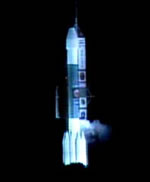
Image credit: NASA/JPL
NASA has decided to push back the launch of its second rover, Opportunity, to no earlier than Sunday, July 6 at 0251 GMT (10:51 pm EDT Saturday). The delays give engineers time to repair insulation which is failing to adhere properly to the first stage of the Delta II rocket. The launch was delayed over the weekend because of poor weather. If all goes well, Opportunity will follow NASA’s previous rover, Spirit, already en route to Mars to search for evidence of life on the Red Planet.
The launch of the MER-B ?Opportunity? Mars Exploration Rover aboard the Boeing Delta II Heavy Iaunch vehicle has been postponed to no earlier than Saturday, July 5.
A decision was made today to take additional time to perform tests on the process used to bond the cork insulation to the surface of the Delta II launch vehicle. These tests should be complete late on Wednesday.
The launch times on Saturday evening are: 10:51:25 p.m. and 11:34:05 p.m. EDT.
Original Source: NASA News Release
Book Review: Made in Space
Got a little extra cash and looking for the next high-flying investment opportunity? Maybe you need to look up? way up. In his book: Made in Space: Space Investor’s Guide to the Next Revolution, Kenneth Schweitzer covers a whole range of investment opportunities, from space-based manufacturing facilities to power generation and mining. Here’s Fraser’s review…
Got a little extra cash and looking for the next high-flying investment opportunity? Maybe you need to look up? way up. In his book: Made in Space: Space Investor’s Guide to the Next Revolution, Kenneth Schweitzer covers a whole range of investment opportunities, from space-based manufacturing facilities to power generation and mining.
Through the course of 250 pages, Schweitzer makes a case that the private space industry is about to really take off, thanks to maturing technologies, military and government investment, public demand, and several other factors.
Each chapter of Made in Space is devoted to a different aspect of space commercialization, from space-based mining to space tourism, and Schweitzer does a pretty good job of providing a comprehensive look at the current companies in each segment and then the future opportunities. For example, the chapter on Public Space Travel examines the basis for the space tourism industry, the two tourists who’ve already flown (Tito and Shuttleworth), and then provides an overview of several companies offering space tourism flights (now, or in the near future).
One aspect of the book that I really enjoyed is how Schweitzer takes a fairly balanced view of of space commercialization achieved so far. Like most space enthusiasts, he’s disappointed about the pace of space flight, but he’s also appreciative of the work that’s already been done. In fact, he considers many of the experiments already performed by NASA and Russia to be critical to the future of space-based manufacturing.
Although Made in Space was written to serve as an investor’s guide to space, I’m not sure it will serve that role too well. The problem is that space commercialization is based on two insanely risky ventures: space exploration and business entrepreneurship. The book covers all of the insanely risky ventures going on, but it doesn’t exactly provide any kind of analysis of the different companies involved. So, if you’re actually considering investment in a space company, you’ll want to use this book as a starting point, not a detailed financial analysis of the different companies. I don’t think you’d be able to spot the next “hot space stock” from within Made in Space‘s pages.
I also felt that the book was overly optimistic. From reading Made in Space, you get the impression that the space revolution is ready to begin; nothing’s stopping it now! This is just my opinion, but I think space commercialization isn’t going to get going without overwhelming effort from thousands of people against enormous resistance. We’re by no means “in the clear”, and a large part of this momentum will need to come from revised government policies. This is the kind of thing that only happens when thousands of people lobby the government to change the way it supports space exploration – right now the US government (and world governments in general) are showing few signs of supporting these kinds of revolutionary ventures.
Here’s a link to Made in Space from Amazon.com. And a link directly from the publisher.
Opportunity Set for Weekend Launch
NASA’s second Mars Explorer rover, Opportunity, is set for launch on the weekend atop a Delta II rocket from Cape Canaveral, Florida. If all goes well, the spacecraft will lift off at 0356 GMT Sunday (11:56 pm EDT Saturday) and join the previous rover, Spirit, en route to the Red Planet. Weather forecasts currently give the rover a 60% chance of acceptable conditions for flight. Opportunity is targeted to land at Meridiani Planum, which is a prime location for search for past life on Mars.
Odyssey Reveals More of Frosty Mars
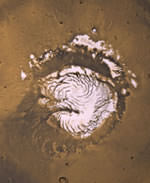
Image credit: NASA/JPL
It turns out that Mars has been hiding its water underneath a layer of dry ice. By tracking the seasonal changes at Mars northern ice cap, NASA’s Mars Odyssey spacecraft has watched how a layer of carbon dioxide permafrost comes and goes. When the permafrost dissipates in the Spring, Mars reveals a soil layer mixed with large amounts of water ice. In some places, the water ice content is more than 90% by volume. During the winter, the dry ice permafrost can reach more than a metre in thickness.
NASA’s Mars Odyssey spacecraft is revealing new details about the intriguing and dynamic character of the frozen layers now known to dominate the high northern latitudes of Mars. The implications have a bearing on science strategies for future missions in the search of habitats.
Odyssey’s neutron and gamma-ray sensors have tracked seasonal changes as layers of “dry ice” (carbon-dioxide frost or snow) accumulate during northern Mars’ winter and then dissipate in the spring, exposing a soil layer rich in water ice– the martian counterpart to permafrost.
Researchers used measurements of martian neutrons combined with height measurements from the laser altimeter on another NASA spacecraft, Mars Global Surveyor, to monitor the amount of dry ice during the northern winter and spring seasons.
“Once the carbon-dioxide layer disappears, we see even more water ice in northern latitudes than Odyssey found last year in southern latitudes,” said Odyssey’s Dr. Igor Mitrofanov of the Russian Space Research Institute (IKI), Moscow, lead author of a paper in the June 27 issue of the journal Science. “In some places, the water ice content is more than 90 percent by volume,” he said. Mitrofanov and co-authors used the changing nature of the relief of these regions, measured more than 2 years ago by the Global Surveyor’s laser altimeter science team, to explore the implications of the changes.
Mars Odyssey’s trio of instruments, called the gamma-ray spectrometer suite, can identify elements in the top meter (3 feet) or so of Mars’ surface. Mars Global Surveyor’s laser altimeter is precise enough to monitor meter-scale changes in the thickness of the seasonal frost, which can accumulate to depths greater than a meter. The new findings show a correlation in the springtime between Odyssey’s detection of dissipating carbon dioxide in latitudes poleward of 65 degrees north and Global Surveyor’s measurement of the thinning of the frost layer in prior years.
“Odyssey’s high-energy neutron detector allows us to measure the thickness of carbon dioxide at lower latitudes, where Global Surveyor’s altimeter does not have enough sensitivity,” Mitrofanov said. “On the other hand, the neutron detector loses sensitivity to measure carbon-dioxide thickness greater than one meter (3 feet), where the altimeter obtained reliable data. Working together, we can examine the whole range of dry-ice snow accumulations.”
“The synergy between the measurements from our two ‘eyes in the skies of Mars’ has enabled these new findings about the nature of near-surface frozen materials, and suggests compelling places to visit in future missions in order to understand habitats on Mars,” said Dr. Jim Garvin, NASA’s Lead Scientist for Mars Exploration.
Another report, to be published in the Journal of Geophysical Research-Planets, combines measurements from Odyssey and Global Surveyor to provide indications of how densely the winter layer of carbon-dioxide frost or snow is packed at northern latitudes greater than 85 degrees. The Odyssey data are used to estimate the mass of the deposit, which can then be compared with the thickness to obtain a density. The dry-ice layer appears to have a fluffy texture, like freshly fallen snow, according to the report by Dr. William Feldman of Los Alamos National Laboratory, N.M., and 11 co-authors. The study also found that once the dry ice disappears, the remaining surface near the pole is composed almost entirely of water ice.
“Mars is constantly changing,” said Dr. Jeffrey Plaut, Mars Odyssey project scientist at NASA’s Jet Propulsion Laboratory, Pasadena, Calif. With Mars Odyssey, we plan to examine these dynamics through additional seasons, to watch how the winter accumulations of carbon dioxide on each pole interact with the atmosphere in the current climate regime.”
Mitrofanov’s co-authors include researchers at the Institute for Space Research of the Russian Academy of Science, Moscow; MIT, Cambridge, MA; NASA’s Goddard Space Flight Center, Greenbelt, Md.; TechSource, Santa Fe, N.M.; and NASA Headquarters, Washington. Feldman’s co-authors include researchers at New Mexico State University, Las Cruces; Cornell University, Ithaca, N.Y.; and Observatoire Midi-Pyrenees, Toulouse, France.
JPL manages the Mars Odyssey and Mars Global Surveyor missions for NASA’s Office of Space Science in Washington. Investigators at Arizona State University, the University of Arizona, and NASA’s Johnson Space Center, Houston, built and operate Odyssey science instruments. The Russian Aviation and Space Agency supplied the high-energy neutron detector and Los Alamos National Laboratory supplied the neutron spectrometer. NASA’s Goddard Space Flight Center supplied Global Surveyor’s laser altimeter. Information about NASA’s Mars exploration program is available online at: http://mars.jpl.nasa.gov
Original Source: NASA/JPL News Release
Pegasus Rocket Launches Imaging Satellite
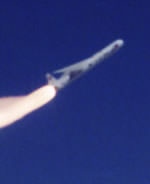
Image credit: Orbital Sciences
Orbital Sciences Pegasus rocket carried an Orbview-3 satellite into orbit Thursday. The Pegasus is different from most rockets because it’s carried underneath the wing of an aircraft and then launched from the air. The Pegasus detached from its L-1011 carrier aircraft and then placed the Orbview-3 high-resolution imaging satellite into a parking orbit 10 minutes later.
Orbital Sciences Corporation (NYSE: ORB) announced that earlier today, it successfully launched the company-built OrbView-3 high-resolution imaging satellite into its targeted orbit aboard the company’s Pegasus? rocket. The OrbView-3 satellite was accurately delivered into an initial “parking” orbit and, over the next several weeks, Orbital engineers will command the satellite to use its onboard propulsion system to reach its final circular operational orbit of 470 kilometers above the Earth, inclined at 97 degrees to the equator. Orbital designed, developed, built and tested the 304-kilogram OrbView-3 satellite for Orbital Imaging Corporation (ORBIMAGE) at the company’s Dulles, Virginia satellite manufacturing facility.
The powered flight sequence for the OrbView-3 mission took about 10 minutes, from the time the Pegasus rocket was released from its L-1011 carrier aircraft at approximately 2:55 p.m. (EDT) to the time that the satellite was deployed into orbit. Preliminary information indicates that the OrbView-3 satellite is working as planned in the early stages of its mission.
“We are very pleased with the results of the Pegasus launch and with the early indications that the OrbView-3 satellite is operating as expected,” said Mr. David W. Thompson, Orbital’s Chairman and Chief Executive Officer. “We look forward to delivering a highly-capable satellite that will allow ORBIMAGE to provide its customers with world-class imagery products.”
Orbital develops and manufactures small space systems for commercial, civil government and military customers. The company’s primary products are spacecraft and launch vehicles, including low-orbit, geostationary and planetary satellites for communications, remote sensing and scientific missions; ground- and air-launched rockets that deliver satellites into orbit; and missile defense boosters that are used as interceptor and target vehicles. Orbital also offers space-related technical services to government agencies and develops and builds satellite-based transportation management systems for public transit agencies and private vehicle fleet operators.
Original Source: Orbital News Release
